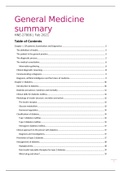Samenvatting
Summary General Medicine course
- Instelling
- Wageningen University (WUR)
This summary includes everything that has to be learned for the exam, including a glossary of all topics. The book, knowlegde clips and fact sheets are all covered.
[Meer zien]














